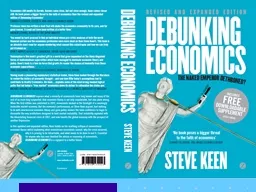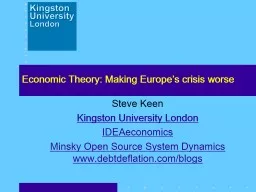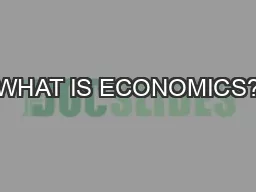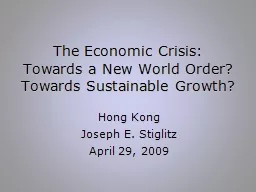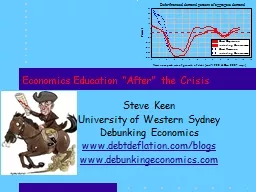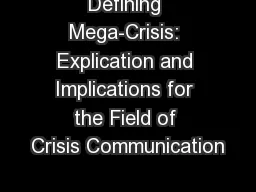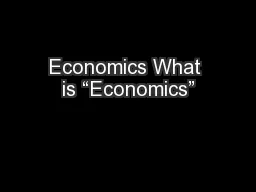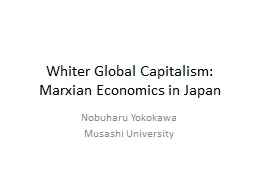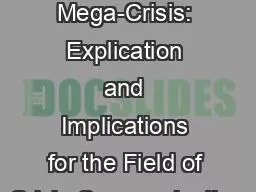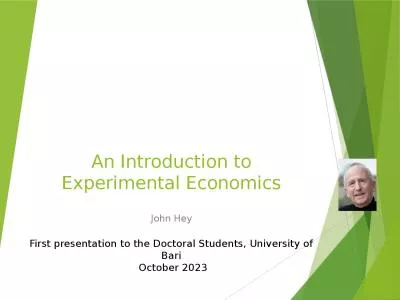PPT-The crisis in economics & economic theory
Author : alexa-scheidler | Published Date : 2016-06-01
Steve Keen University of Western Sydney Debunking Economics wwwdebtdeflationcomblogs wwwdebunkingeconomicscom Macroeconomics Before the Crisis Triumphalism Macroeconomics
Presentation Embed Code
Download Presentation
Download Presentation The PPT/PDF document "The crisis in economics & economic t..." is the property of its rightful owner. Permission is granted to download and print the materials on this website for personal, non-commercial use only, and to display it on your personal computer provided you do not modify the materials and that you retain all copyright notices contained in the materials. By downloading content from our website, you accept the terms of this agreement.
The crisis in economics & economic theory: Transcript
Steve Keen University of Western Sydney Debunking Economics wwwdebtdeflationcomblogs wwwdebunkingeconomicscom Macroeconomics Before the Crisis Triumphalism Macroeconomics was born as a distinct field in the 1940s as a part of the intellectual response to the Great . Nobuharu Yokokawa. Musashi University. Heterodox Economics Organizations. Japan . Society of political Economy. Political Economy & Economic History Society. Japan Association for Evolutionary Economics. Steve Keen. Kingston University London. IDEAeconomics. Minsky Open Source System Dynamics. www.debtdeflation.com/blogs. What is Post Keynesian Economics?. According to . Diane . Coyle. , one of the authors of the . Economic Reality. The Economic Myth . Economic choices involve only money.. Economic Reality. Economics focuses on choices, the choices that we make every day. Both as individuals and as a society.. Economics. Towards a New World Order?. Towards Sustainable Growth?. Hong Kong. Joseph E. Stiglitz. April 29, 2009. We are not out of the Woods…. The world has pulled back from the brink where it was in September 2008. Crisis. Steve Keen. University of Western Sydney. Debunking Economics. www.debtdeflation.com/blogs. www.debunkingeconomics.com. Before the Crisis. Oliver Blanchard, founding editor of . AER Macro. “. Jenna L. Currie-Mueller. Background. Organization is privileged. Expanding field and contexts. Need inclusivity. A new form of crisis. Tight-coupling . Increased entropy of society. New events that defy current understanding. There’s no doubt that Chicago was distinctive, and has been ever since. The real distinction was not making price theory the focal point of the graduate curriculum. That isn’t the real distinction at all. The fundamental distinction is treating economics as a serious subject versus treating it as a branch of mathematics, and treating it as a scientific subject as opposed to an aesthetic subject, if I might put it that . Laibson. & List, 2015). Definition. Introduction to Behavioral Economics. www.EconEdLink.org . 2. System 1 – “operates automatically and quickly, with little or no effort and no sense of voluntary control.”. La gamme de thé MORPHEE vise toute générations recherchant le sommeil paisible tant désiré et non procuré par tout types de médicaments. Essentiellement composé de feuille de morphine, ce thé vous assurera d’un rétablissement digne d’un voyage sur . Introduction. How would you define economics?. Why are some people and nations wealthy and others poor?. Key Terms. Economics: . the . study of how people choose to use their limited resources to satisfy their unlimited . Nobuharu Yokokawa. Musashi University. Heterodox Economics Organizations. Japan . Society of political Economy. Political Economy & Economic History Society. Japan Association for Evolutionary Economics. Jenna L. Currie-Mueller. Background. Organization is privileged. Expanding field and contexts. Need inclusivity. A new form of crisis. Tight-coupling . Increased entropy of society. New events that defy current understanding. John Hey. First presentation to the Doctoral Students, University of Bari. October 2023. Information. I am John Hey, Emeritus Professor of Economics and Statistics at the University of York.. I have constructed a site for this course of lectures at . vs technologic progress in macro-economics. LIU Cheng, Shanghai Normal University. I. Introduction. The current . macro-economic theories are out of line with micro-economic theories. . Mainstream economics recognizes the role of creative labor in...
Download Document
Here is the link to download the presentation.
"The crisis in economics & economic theory"The content belongs to its owner. You may download and print it for personal use, without modification, and keep all copyright notices. By downloading, you agree to these terms.
Related Documents

